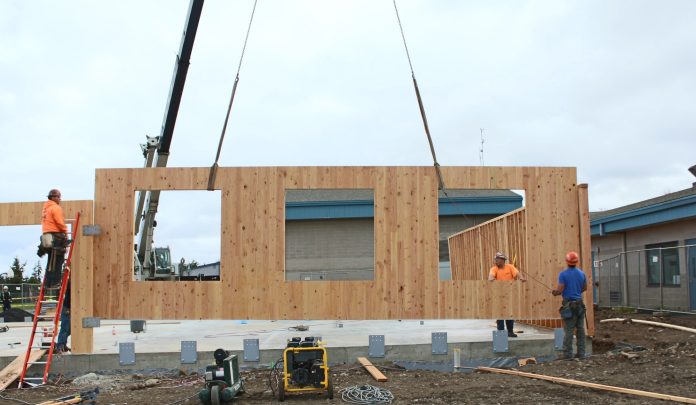It is a little known fact that one of the biggest drivers of global carbon dioxide (CO2) emissions is the construction of new buildings. Together, cement and steel production account for 14% of global emissions, and in 2016 buildings and construction accounted for 36% of global energy use and 39% of related CO2 emissions when upstream power generation was included. These numbers make it clear: construction, and buildings themselves, can be big drivers of global warming.
Fortunately, a traditional material is here in an updated form to help save the day. New materials techniques have allowed for the large-scale prefabrication of solid wood panel, referred to as mass timber products. Cross-laminated timber (CLT) panels are the most prevalent and consist of multiple layers of kiln-dried lumber stacked in alternating directions and bonded with adhesives before being pressed. These panels are lightweight yet exceedingly strong with excellent fire safety, seismic, and thermal performance. While mass timber is a hot topic in urban development classes and construction industry circles, there is little widespread public knowledge of the substantial benefits of cross-laminated timber over concrete and steel.
One benefit is in construction speed: CLT panels are cut to size at the mill and shipped to construction sites allowing for quick and easy assembly. The production of one laminated wood beam compares favorably to that of a steel beam of comparable strength while using only one-sixth of the energy required for steel. Mass timber also offers significant environmental advantages due to the carbon that is captured by trees as they grow, mitigating the effects of climate change by capturing carbon in wooden buildings at a rate of one cubic meter of wood storing one ton of carbon dioxide.
Furthermore, wooden window frames provide nearly 400 times as much insulation compared to steel and over a thousand times as much as aluminum, further increasing the energy savings and limiting environmental impact. Another 2012 study tracking building materials from cradle to construction, concluded that CLT offered a lower environmental impact than reinforced concrete in 10 out of 11 scenarios as well as large improvements in carbon capture and sequestration. In short, using mass timber products reduces our carbon emissions while also sequestering carbon. Mass timber construction could be a critical tool to quickly reduce carbon emissions and mitigate our impact on the climate.
The passage of the Timber Innovation Act, officially signed into law in December as part of the national Farm Bill, is a big step for incentivizing the use of CLT. One of the most important provisions of the bill is that it provides annual matching grants to advance innovation in wood construction including prioritizing the use of funds to retrofit sawmills in areas of high unemployment. The increased research and development, education and technical assistance opportunities offered by the Timber Innovation Act are another positive sign for the mass timber industry and another opportunity for Washington State to achieve sustainable working forests.
Our very own Senator Maria Cantwell (D-Washington) hit the nail on the head when she said, “The Timber Innovation Act will create new jobs across rural Washington by fostering innovation. The building technologies promoted in our bill, like cross-laminated timber, will bring several wins to Washington including faster construction of buildings, more eco-friendly buildings and new timber jobs.” The passage of this bill marks a huge opening for Washington to jumpstart stagnant economic growth in rural Washington counties that for years have been heavily reliant on the timber industry; not to mention addressing environmental concerns and the increasing need for housing.

Some steps are already being taken to make Washington State a center for mass timber innovation. The Washington State Building Code Council (SBCC) made code changes last fall that will allow for the use of mass timber in buildings as tall as 18-stories. Washington is the first state in the nation to allow mass timber buildings without pursuing an alternative method, and Oregon has passed similar language.
The International Code Council is following the SBCC’s lead and after two years of testing, including controlled burns of five different cross-laminated timber structures by the National Bureau of Alcohol, Tobacco, Firearms, and Explosives, is embracing tall timber buildings in the United States. This refutes one of the common arguments made by alarmists in regard to mass timber: the danger of fire. In truth, cross-laminated timber panels outperform steel panels in fire tests.
Seattle’s origin as a timber town makes it a poetically appropriate place for CLT structures to have an impact. In May, the Seattle City Council approved the construction of CLT buildings up to six-stories on a two-story concrete base. In the wake of the SBCC’s decision to allow CLT buildings up to 18-stories Seattle should follow suit.

Other Pacific Northwest cities are already pursuing ambitious CLT projects of a similar scale. Vancouver BC’s 18-story Brock Commons, constructed in 2017, is almost entirely constructed out of CLT. Construction was finished a mere 70 days after the arrival of the prefabricated CLT panels, a full four months faster than a similar concrete and steel structure.
With vast timber resources and ready for retrofit facilities, the Pacific Northwest has an opportunity to lead a revolution in sustainable building and with the major challenges Seattle is facing around housing affordability and homelessness, our city can and should be at the center of demand for mass timber. We need to act now if we want Washington State to be the place to capture the huge economic potential of mass timber.
California recently announced a $500,000 prize for “viable and repeatable” mass timber solutions in the state with one of the stated objectives of the project being to stimulate interest in potential in-state production capacity. This doesn’t mean we should clear cut our forests. Instead, this is an opportunity for sustainable, working forests through environmental groups and industry working hand in hand. With responsible and economically incentivized forest management, we can change the calculus of deforestation, encourage replanting and continued harvesting as younger and lower grade trees can be used in mass timber products such as CLT.
Together, we can work across the divides of party and geography to advance a new and exciting industry benefiting urban and rural Washingtonians alike. It is time for us to revisit our roots as a timber state and do our part to reduce global CO2 emissions.
Conor Bronsdon is a consultant at Olive & Goose specializing in applying technology to social challenges. He serves as the Legislative Action Chair of the Washington Blockchain Coalition and is a former Executive Board Member of the League of Women Voters of Washington. You can read more of his writing at conorbronsdon.com
Andrew Lewis is a Seattle native and attorney with a passion for public policy and civic discourse. A former Henry M. Jackson Leadership Fellow, he currently is an assistant city attorney for the City of Seattle. You can read more of his writing at Crosscut.
Featured image courtesy of Forterra, showing construction crews install cross-laminated timber panels while building new classrooms at Greywolf Elementary School in Sequim, one of the schools selected for a pilot project that builds new class space with CLT.




